Ringing Strings Bowed Psalteries
handcrafted by Rick Long
Clinton, Tennessee
(865) 660-4026
psalteryman@gmail.com
psalteryman@gmail.com
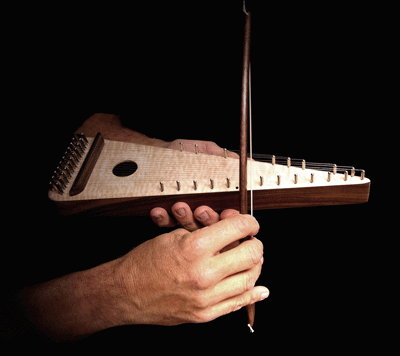
I have built and played the bowed psaltery for over thirty years now. I have experimented with a lot of different bow types and the materials to use for hair. Here's what I have concluded.
The brand of synthetic hair I use is best for psalteries with plain steel strings, most soprano psalteries fit into this category. Very smooth sound and no adjustment of the hair needed, because it is a synthetic. Very good string vibration and overall just a good material. These are a little over 14", though the actual usable length of the bow hair is right at 13".
For psalteries having wound strings, I use black horsehair. It is a coarse hair and is just right for the best sound on those rough wound strings. This being said, I have noticed the black hair will smooth out over time, so they will work with plain steel strings, if you would prefer horsehair. These bows are a little under 16", but the usable length of bow hair is about the same as the synthetic haired bows, at 13". That extra length is for the sliding piece I use to adjust the tension on these bows. Horsehair will react to humidity changes and will also stretch over time. This is why the adjustment is needed. I have also started using some white horsehair. I actually don't hear or feel a lot of difference between the white or black hair.
So you see, the playing length of the hair is the same on the two types of bows. That 13" may sound pretty short to you. A common misconception is that you need a longer bow to hold out the long notes or drones. That falls back to using the proper technique while playing. Rushing through the bow stroke is never a good idea. Any note you hold out, the bow stroke should be fairly slow and controlled. It is time well spent, to work on your bowing technique.
My bows are also extremely light in weight. A lighter bow is much easier to maneuver around on the bowed psaltery strings. A violin bow is heavy, but that is needed on a violin, you stay more in contact with the strings all the time you are playing. On a bowed psaltery, you are constantly lifting and moving to the various notes you need. A heavy bow will slow you down.
The key things are to have a lightweight bow, not too long, and the proper hair to give you the best sound.
My bows are designed for playing a bowed psaltery. Some folks say a fractional violin bow is good for playing the psaltery. The problems I have found are that they are not comfortable to grip, except at the base. That round shaft is not friendly to any kind of comfort when gripping it. A violin bow is designed to use it's weight to keep the hair in contact with the strings. The opposite is needed for playing a psaltery, unless you are planning on playing the same note, you must lift the bow to move to the next notes of a song. Depending on the tempo of a song, that could happen very quickly. My bows are designed to have a nice flat area, that extends to about half the length, to give you an easy and comfortable gripping surface, in many different places along the length. Google search this phrase "violin bow makes my hand hurt" and see all the hits from folks that are experiencing pain from playing the violin. It's a poor design and choice for playing the bowed psaltery. There's no need to ever be in any kind of pain or discomfort when playing your psaltery. If there is, you aren't going to want to spend much time playing.
The wide surface of bow hair, on a violin bow, is not ideal for playing the psaltery. That extra width causes you to make an extra effort to be accurate, and that extra effort can have an effect on playing tunes at a faster tempo. You only have a small area between each hitch pin to bow the string. In trying a violin bow, I quickly found out it is very easy to end up with the hair split between two pins. You never want that to happen. Some folks will also try to say a violin bow will give you better tone or volume. This is simply not true. The rosined bow hair is causing the friction needed to make the string vibrate. Varying the pressure with the bow is how you regulate the volume, and is one of the best things to learn when developing your bowing technique. Using this technique to range from a feathery light touch to the max volume your psaltery is capable of. How a psaltery is constructed will be what determines the final output of tone and volume. Mastering that technique is well worth spending the time to practice. A fractional violin bow will be heavy, even the 1/16 size is heavier than any of the bows I build. That weight works against you, when your skills develop into playing faster tunes. It can lead to your playing sounding sloppy. In playing a violin, you mostly stay in contact with the string. On the psaltery, you are constantly required to lift the bow to move onto the next notes of a tune. A lightweight bow shines here.
======================================================================================================
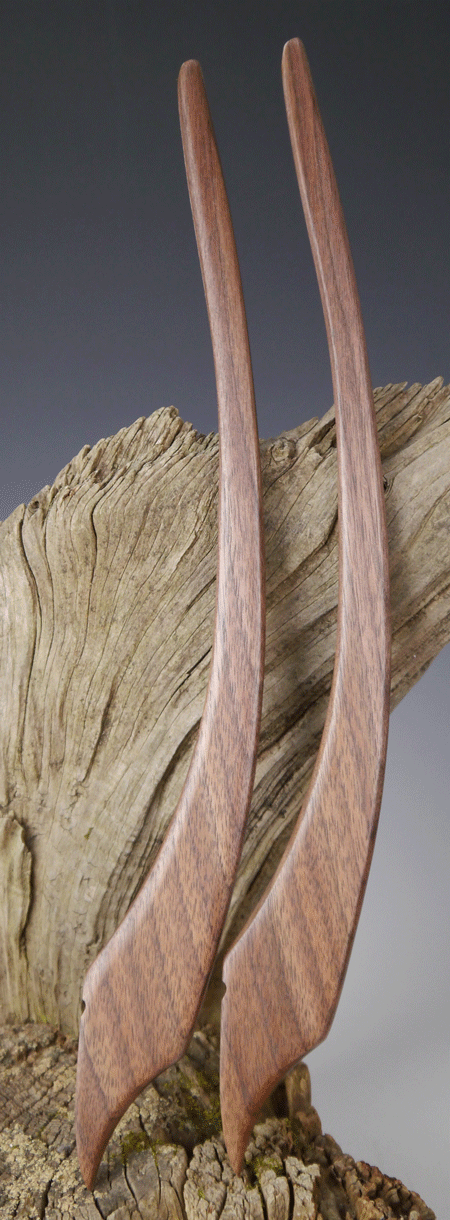
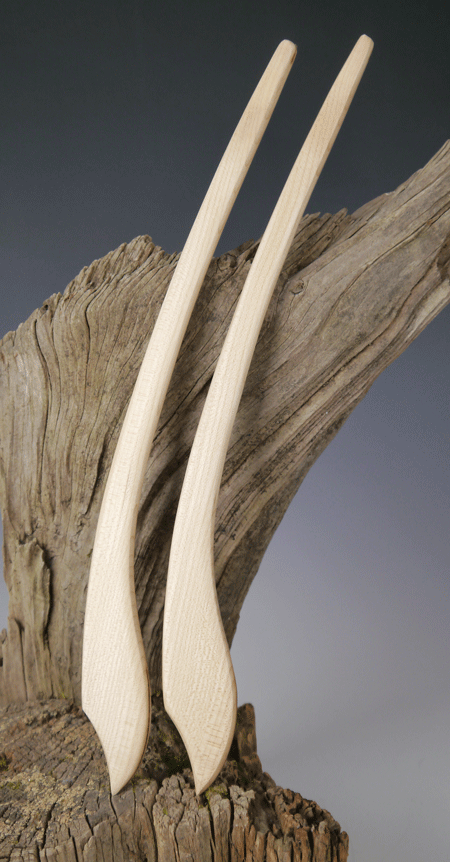
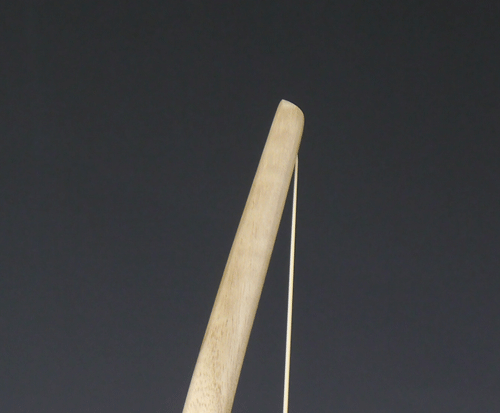
I have changed the way I will offer my bows for sale on the website. I'll show you the types of bows with the kinds of wood I can make them from.
Here are how they are priced -
Single bows designed for synthetic hair are $20 for walnut, maple or cherry. If you specify a figured wood, like a figured maple or the curly golden raintree you see below, they are $5 more. On these bows the hair tension is not adjustable. They are the ones with a rounded bottom on the large end, like the maple pair in the second picture down.
Single bows designed for horsehair are $25 for walnut, maple, or cherry. Figured woods can be requested. Add $5 for figured wood. The horsehair bows are like the walnut pair to the left, flat bottom on the large end with a notch to park the adjuster.
Bow pairs are available in any of these woods. They will match in color, size, and weight. The walnut pair to the right are a matched pair. Remember the single bow like the walnut pair is $25, so that pair is $50. The maple pair in the second photograph is $40, remember that style is $20 each.
Any that you order will only take a couple of days to complete.
I ship the bows by USPS Priority Mail here in the US. When you inquire about ordering, be sure to let me know your Zip code. I can calculate ther shipping cost. Sorry, no International sales.
A new design feature for the matched pairs is to have the knot for the bow hair recessed, at the tip of the bow. This completely gets that little knot out of the way. There is one technique in double bowing, where those little knot would cause you to get your bows tangled. That is the technique where you alternate each bow for each successive note. In perfroming this technique the tips of the bows cross very closely together when reaching for the next note. Just a little problem that needed a solution. This is what I came up with.
Not all the single bows will have this recessed knot. If you are buying an extra bow with double bowing in mind, you need to specify that you want it.
Matched pair of walnut bows for horsehair
Matched pair of maple bows for synthetic hair.
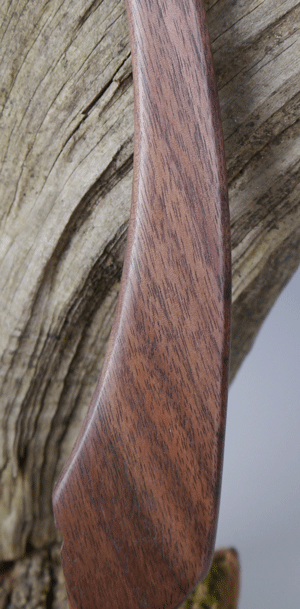
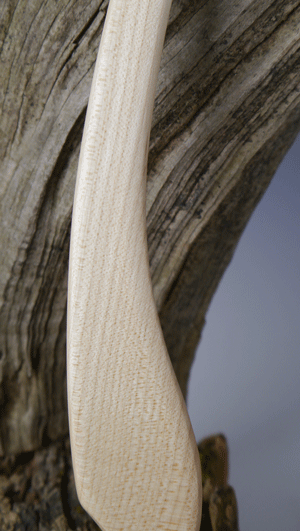
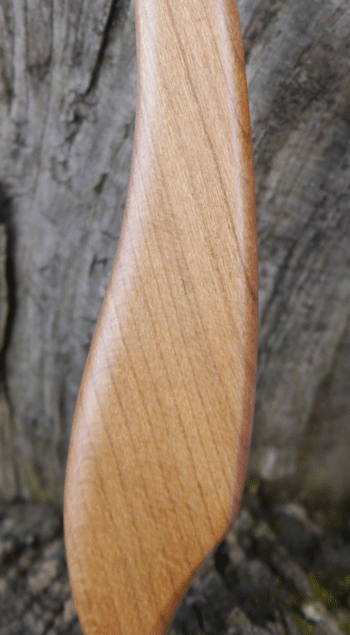
These are the woods available for the $20 synthetic and the $25 horse hair bows. Matched pair are double that - $40 and $50.
Walnut
Maple
Cherry